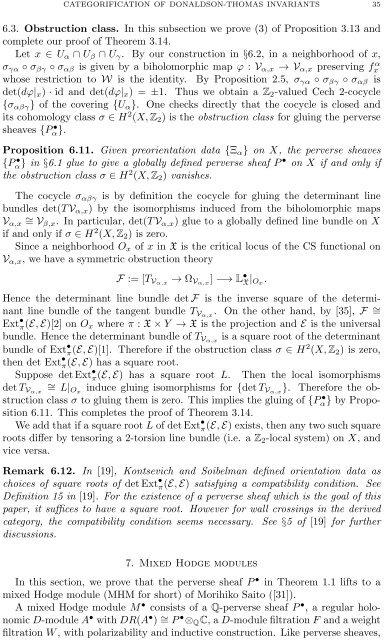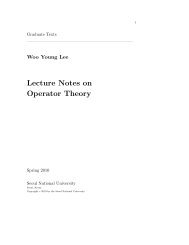Categorification of Donaldson-Thomas invariants via perverse ...
Categorification of Donaldson-Thomas invariants via perverse ...
Categorification of Donaldson-Thomas invariants via perverse ...
You also want an ePaper? Increase the reach of your titles
YUMPU automatically turns print PDFs into web optimized ePapers that Google loves.
CATEGORIFICATION OF DONALDSON-THOMAS INVARIANTS 356.3. Obstruction class. In this subsection we prove (3) <strong>of</strong> Proposition 3.13 andcomplete our pro<strong>of</strong> <strong>of</strong> Theorem 3.14.Let x ∈ U α ∩ U β ∩ U γ . By our construction in §6.2, in a neighborhood <strong>of</strong> x,σ γα ◦ σ βγ ◦ σ αβ is given by a biholomorphic map ϕ : V α,x → V α,x preserving fxαwhose restriction to W is the identity. By Proposition 2.5, σ γα ◦ σ βγ ◦ σ αβ isdet(dϕ| x ) · id and det(dϕ| x ) = ±1. Thus we obtain a Z 2 -valued Cech 2-cocycle{σ αβγ } <strong>of</strong> the covering {U α }. One checks directly that the cocycle is closed andits cohomology class σ ∈ H 2 (X, Z 2 ) is the obstruction class for gluing the <strong>perverse</strong>sheaves {P α}.•Proposition 6.11. Given preorientation data {Ξ α } on X, the <strong>perverse</strong> sheaves{P • α} in §6.1 glue to give a globally defined <strong>perverse</strong> sheaf P • on X if and only ifthe obstruction class σ ∈ H 2 (X, Z 2 ) vanishes.The cocycle σ αβγ is by definition the cocycle for gluing the determinant linebundles det(T V α,x ) by the isomorphisms induced from the biholomorphic mapsV α,x∼ = Vβ,x . In particular, det(T V α,x ) glue to a globally defined line bundle on Xif and only if σ ∈ H 2 (X, Z 2 ) is zero.Since a neighborhood O x <strong>of</strong> x in X is the critical locus <strong>of</strong> the CS functional onV α,x , we have a symmetric obstruction theoryF := [T Vα,x → Ω Vα,x ] −→ L • X| Ox .Hence the determinant line bundle det F is the inverse square <strong>of</strong> the determinantline bundle <strong>of</strong> the tangent bundle T Vα,x . On the other hand, by [35], F ∼ =Ext • π(E, E)[2] on O x where π : X × Y → X is the projection and E is the universalbundle. Hence the determinant bundle <strong>of</strong> T Vα,x is a square root <strong>of</strong> the determinantbundle <strong>of</strong> Ext • π(E, E)[1]. Therefore if the obstruction class σ ∈ H 2 (X, Z 2 ) is zero,then det Ext • π(E, E) has a square root.Suppose det Ext • π(E, E) has a square root L. Then the local isomorphismsdet T Vα,x∼ = L|Ox induce gluing isomorphisms for {det T Vα,x }. Therefore the obstructionclass σ to gluing them is zero. This implies the gluing <strong>of</strong> {P α} • by Proposition6.11. This completes the pro<strong>of</strong> <strong>of</strong> Theorem 3.14.We add that if a square root L <strong>of</strong> det Ext • π(E, E) exists, then any two such squareroots differ by tensoring a 2-torsion line bundle (i.e. a Z 2 -local system) on X, andvice versa.Remark 6.12. In [19], Kontsevich and Soibelman defined orientation data aschoices <strong>of</strong> square roots <strong>of</strong> det Ext • π(E, E) satisfying a compatibility condition. SeeDefinition 15 in [19]. For the existence <strong>of</strong> a <strong>perverse</strong> sheaf which is the goal <strong>of</strong> thispaper, it suffices to have a square root. However for wall crossings in the derivedcategory, the compatibility condition seems necessary. See §5 <strong>of</strong> [19] for furtherdiscussions.7. Mixed Hodge modulesIn this section, we prove that the <strong>perverse</strong> sheaf P • in Theorem 1.1 lifts to amixed Hodge module (MHM for short) <strong>of</strong> Morihiko Saito ([31]).A mixed Hodge module M • consists <strong>of</strong> a Q-<strong>perverse</strong> sheaf P • , a regular holonomicD-module A • with DR(A • ) ∼ = P • ⊗ Q C, a D-module filtration F and a weightfiltration W , with polarizability and inductive construction. Like <strong>perverse</strong> sheaves,













